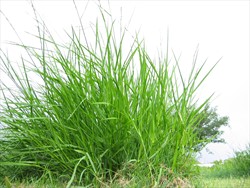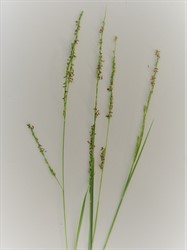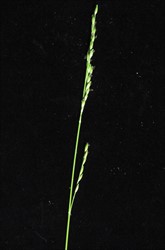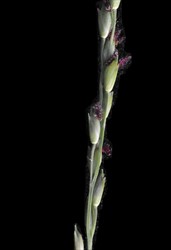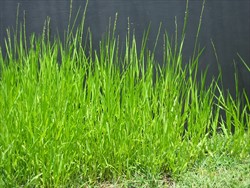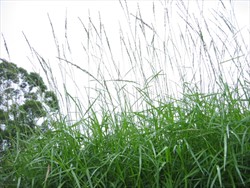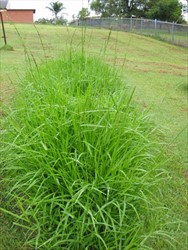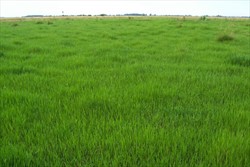Acroceras macrum
Tropical Forages
Acroceras macrum Stapf
Neohusnotia macra (Stapf) C.C. Hsu
Family: Poaceae (alt. Gramineae) subfamily: Panicoideae tribe: Paniceae.
Erect to prostrate perennial, with creeping solid, fibrous rhizomes and hollow stolons, 2.5‒4 mm in diameter; culms hollow, erect/decumbent, sparingly branched, 20‒70 cm (rarely >1 m) tall, rooting from lower nodes; culm-nodes glabrous. Leaf blades bright green, linear-lanceolate to ovate-lanceolate, 8‒20 cm long, 5‒12 mm wide; glabrous or minutely hairy, rounded or almost cordate at base, tapering to sharp point; ligule an inconspicuous rim of hairs; leaf sheath glabrous to pubescent, ciliate on margins. Panicle mostly 15‒25 cm long, spikelike, comprising 2‒5 (rarely 1) racemes, 1.5 (upper)‒9 (lower) cm long, widely spaced on a central slender axis, lower raceme sometimes branched; spikelets light green, acuminate or obtuse, 4‒5 mm long, awnless, arranged singly on distinct pedicels, or in pairs, with one of the pair almost sessile, comprising 2 florets, the lower male, the upper bisexual; stigmata purple. 250,000‒300,000 seeds/kg.
English: nile grass, swamp rye grass
Latin America: capim nilo, nilo grama, pântano centeio grama (Brazil)
South Africa: nyl grass, nylgras, nile vlei grass, nylvleigras, nilgras, lidjiegras
Native:
Africa: Angola; Botswana; Democratic Republic of Congo; Ethiopia; Kenya; Malawi; Mozambique; Namibia; South Africa (E. Cape Province, Kwazulu-Natal, Mpumalanga, Limpopo); Tanzania; Uganda; Zambia; Zimbabwe
Naturalized:
Australasia: Australia
Cultivated:
South America: Argentina; Suriname
Forage
Cultivated as permanent pasture for grazing systems. Useful as standover or foggage during dry season. Makes palatable and nutritious hay and is also used for silage. May take long time to cure due to high moisture content. Unsuitable for leys, as it is difficult to eradicate.
Environment
Tolerance of seasonally poor drainage suggests potential for soil conservation in such areas.
Soil requirements
Grows naturally in seasonally flooded valley bottoms, along rivers, in swamps and damp grassland. Grows in poorly drained (vlei) soils with textures ranging from sandy to heavy clays, with an apparent preference for the former. Being susceptible to iron deficiency, it prefers acid soils. Successfully cultivated soils with pH from 4.3 to 7.3.
Moisture
Occurs in areas where moisture accumulates in regions with annual rainfall of 625‒1,500 mm. While it prefers permanent moisture, it can survive and grow well in well-drained soils provided periods of moisture deficit are relatively short. Tolerates seasonal flooding but has little drought tolerance. Best cultivated in areas with annual rainfall >900 mm, although successful under irrigation in areas of lower rainfall.
Temperature
Occurs naturally in tropical and subtropical zones of Africa, from sea level to 2,000 m asl. Adapted to regions with mean annual temperature of 16‒26 °C. Ecotypes vary in their temperature response. Vigorous lowland types do not perform as well at higher altitude, which may relate to temperature response differences. Remains green with light frost but tops killed by heavy frost.
Light
Moderately shade tolerant, comparable with Paspalum conjugatum, but not as good as Axonopus compressus.
Reproductive development
Flowers under long and short photoperiods, although there may be differences among ecotypes. Flowers November to July in southern hemisphere.
Defoliation
Grazed, or cut for hay or silage. Upright leafy varieties best for hay making. Should be mown towards end of wet season (summer) for hay or silage. Tolerant of heavy grazing, but not of trampling. Responds well to controlled management (e.g. recovery is more rapid if defoliated to 10 cm rather than 2 cm). Buried growing points combined with carbohydrate stored in the rhizomes provide an ability to recover from heavy grazing, frost, drought and fire. Old stands that have become "sod-bound", with consequently reduced yields, often benefit from renovation by simple cultivation every few years, breaking up the sod and releasing nitrogen.
Fire
While the recommendation is that it should be protected from hot fires, the high-moisture environments in which A. macrum is grown makes the risk of fire extremely low.
Guidelines for establishment and management of sown forages.
Establishment
Much of the literature refers to poor seed set of A. macrum. While this is not strictly true (see Genetics/breeding), in the absence of commercial seed, vegetative propagation is the most practical alternative. Readily established from splits or cuttings of rhizomes or stolons, which are planted on a 50 cm grid. Establishment can be slow and may take 6‒12 months to achieve full cover. Can also be cut at hay stage and scattered over surface of land and then covered by a disc harrow and rolled but this method is not as successful as establishment by rhizomes and stolons. Need 100 × 50 kg fertilizer bags (c. 7‒10 m³) of planting material/ha. The sprig harvesters and planters used to establish Cynodon dactylon and Arachis glabrata, and the cylindrical bale system of planting Hemarthria altissima in the southern USA, may be able to be adapted for vegetative establishment of this species.
Fresh seed has a high level of dormancy that breaks down after 9 months in storage. Germination can be improved by removing glumes, but caryopses thus exposed are vulnerable to fungi and bacteria and should be germinated under sterile conditions. Seedlings are generally not vigorous.
Fertilizer
Survives under relatively infertile conditions in an unproductive state, but responds well to applications of P and N, particularly the latter. Productivity can be maintained using applications of about 20 kg/ha P each year, with 3 or 4 dressings/year each of 50‒100 kg/ha N. In hay production, special attention should be given to maintaining K supply to plants. Interveinal chlorosis, which can be severe, caused by iron deficiency even on acid soils, can be treated with 1% FeSO4 aqueous spray.
Compatibility (with other species)
Grows with certain legumes, but is sufficiently vigorous to suppress broad-leafed weeds, particularly during the wet season.
Companion species
Grasses: Not normally sown with other grasses. Grows in similar environment to Hemarthria altissima, and may be compatible with this species.
Legumes: Listia bainesii, Lotus uliginosus, Trifolium fragiferum, T. repens, T. semipilosum, Vigna parkeri.
Trifolium spp. best in less acid soils.
Pests and diseases
Two main diseases are leaf spot caused by Phyllosticta sp. and smut caused by Ustilago syntherismae. Susceptibility to these diseases varies with ecotype. A non-pathogenic interveinal chlorosis caused by iron deficiency, even on acid soils, is not uncommon (see Fertilizer).
Ability to spread
Spread by rhizomes and stolons, but limited by availability of suitable environment. Volunteer seedlings are rare.
Weed potential
Can become a weed because difficult to plough out once established. Does not spread readily from seed.
Nutritive value
Has high moisture content, up to 90% of green weight in 4-week regrowth. CP levels of herbage vary from 9 to 17% depending on age and conditions of growth; level in leaves may be as high as 23% and in stems about 8%. Ca levels vary from 0.2 to 0.6%, and P from 0.1 to 0.9%. It has the C3 photosynthetic pathway, which usually indicates a lower propensity for lignin production.
Palatability/acceptability
Extremely palatable maintaining quality and palatability when cut for hay or retained as foggage.
Toxicity
No record of toxicity.
Dry matter
Mostly from 4 to 12 t/ha DM, but from as low as 2, and up to 18 t/ha, depending on growing conditions. Growth tends to be slow in early spring in the subtropics due to temperature.
Animal production
Average daily LWG for cattle grazing A. macrum or fed A. macrum hay is commonly in the range of 0.5‒0.8 kg, and up to 1.3 kg.
Tetraploid (2n = 4x = 36), pentaploid (2n = 45), and hexaploid (2n = 54) races occur. Self-sterile, but highly cross-fertile between strains of similar chromosome number and flowering date. Apomixis may also occur. Percentage seed set for ecotypes in isolation may be 0‒4%, and up to nearly 50% with a compatible ecotype. Potential to breed and select for higher levels of apomixis (for stability of type and seed setting ability), as well as for disease resistance. Tetraploids more susceptible to interveinal chlorosis than pentaploids or hexaploids.
Seed production in existing germplasm has been difficult due to self-sterility. Even with compatible ecotypes, seed yields from small plots have been low, the maximum recorded being 34 kg/ha. The tendency for seed to abscise prematurely cannot be controlled by hormone treatment.
No information available.
- High palatability.
- High quality forage.
- Suited to wet or seasonally flooded land.
- Produces high quality hay.
- Low DM yields compared with Cenchrus clandestinus.
- Difficult to eradicate.
- Difficulty in seed production.
- Need to plant vegetatively.
Ferrari Usandizaga, S.C.F., Brugnoli, E.A., Weiss, A.I., Zilli, A.L., Schedler, M., Pagano, E.M., Martínez, E.J. and Acuña, C.A. (2015) Genetic and morphological characterization of Acroceres macrum Stapf. Grass and Forage Science 70:695–704. doi.org/10.1111/gfs.12148
Gibbs Russell, G.E., Watson, L., Koekemoer, M., Smook, L., Barker, N.P., Anderson, H.M. and Dallwitz, M.J. (1990) Grasses of Southern Africa: An identification manual. Memoirs of the Botanical Survey of South Africa No. 58. Botanical Research Institute, Pretoria, South Africa.
Rhind, J.M.L.C. and Goodenough, D.C.W. (1979) Acroceras macrum Stapf (Nile grass): a review. Proceedings of the Grassland Society of South Africa 14:27–36. doi.org/10.1080/00725560.1979.9648855
'Cedara Select' (also Am8, S85, N69/263) Released in South Africa. High yielding, strongly stoloniferous, hexaploid variety from East Africa, with high leaf spot resistance. Appears identical to Am1. Distributed vegetatively to farmers.
'Taishugrass No.1' (also NLT1) Released in Taiwan. High forage yield and quality. Resistant to rust disease. Grew well through the winter with adequate moisture.
'Taishugrass No.2' (also NLT2) more resistant to weed invasion and producing higher yield than Taishugrass No.1. High milk yields from dairy goats fed on total mixed rations prepared using NLT2 hay or haylage is good.
Selected in South Africa:
Am 32 High yielding tetraploid, bred at Cedara with Am 7 the maternal parent. Fair resistance to leaf spot.
Am 44 High yielding tetraploid, bred at Cedara with Am 5 the maternal parent. High resistance to leafspot.
Am 60 High yielding tetraploid, bred at Cedara; Am 3 × Am 5. Fair resistance to leaf spot.
Am 131 Vigorous lowland type from south coastal Kwazulu-Natal. Ploidy unknown.
Selected in Zimbabwe:
G 406 Highest CP level of 18 grass spp. tested (30 accessions).
